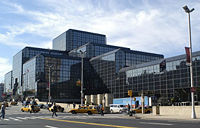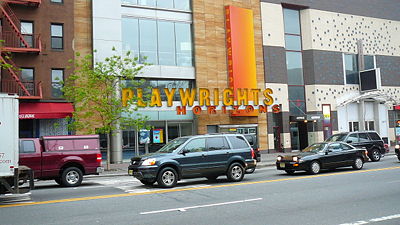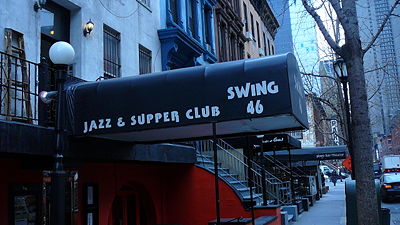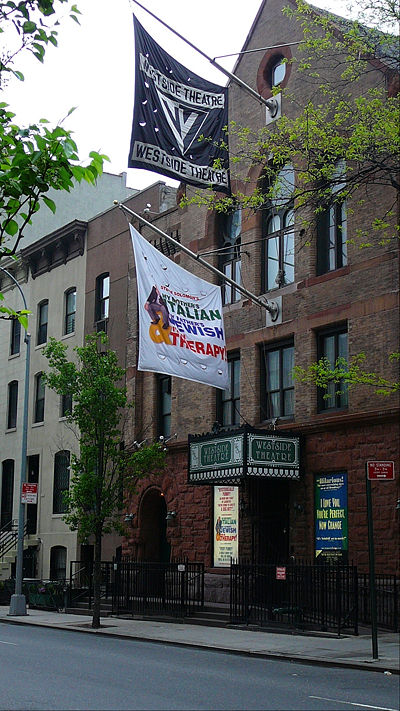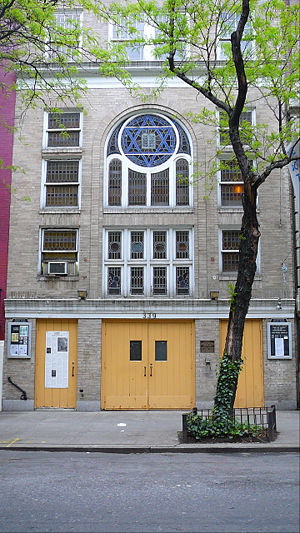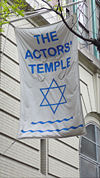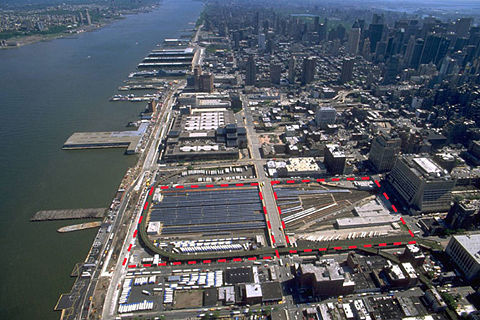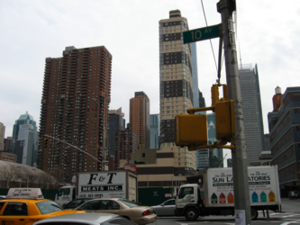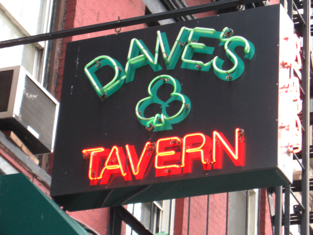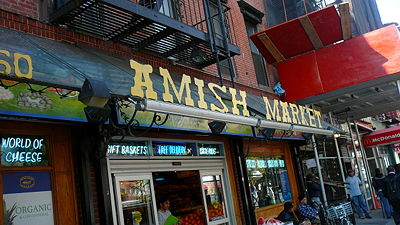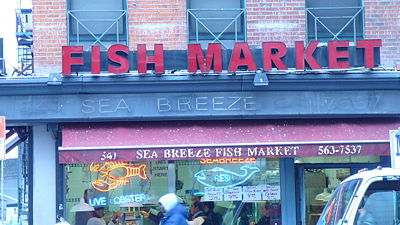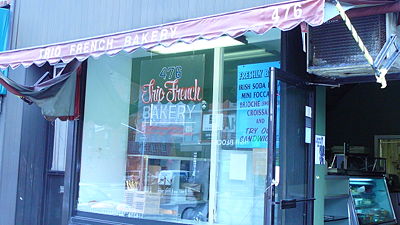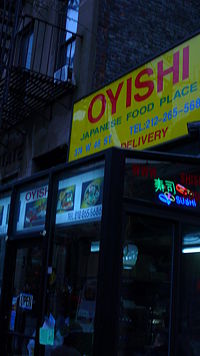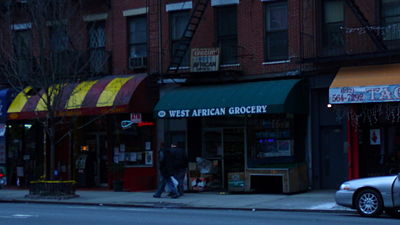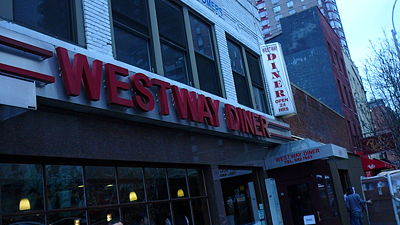From The Peopling of New York City
Contents |
Culture
Geek Culture
Javits Center
The boundaries of Hell's Kitchen encompass many of New York's cultural spots. On the South side, on 34th street and 11th avenue is The "Javits Center" - home to some of the biggest annual "geek" conventions around, such as the Digital Life computer convention, the Toy Fair, the New York International Auto Show, the New York Anime Festival, and in recent memory, the annual New York Comic Con. It is also home to many business gatherings, but those are boring and no one but the men in suits cares for or attends them.
Currently, a plan is underway to expand the Javits Center in order to drastically expand the exhibition space by 240,000 square feet, including an additional 65,000 square feet of ballroom space. The expansion would also entail 180,000 square feet of meeting room space and a Convention Center hotel near by. The plans also advocate that 3.2 acres of public, open space be created at 11th Avenue and 34th Street and centered at large, public plazas. This pedestrian friendly landscaping would be consistent with the city’s other attempts to alleviate street congestion. These improvements are anticipated to increase the number of conventions that were previously too large for the Javits Center. This would increase tourism, profits, and simultaneously fuel the Hudson Yards development’s commercial expansion interests.
Fine Culture
Northside Theater
Also, on the north side at 55th street and 9th avenue is the Alvin Ailey American Dance Theater - while the company running this theater has been around for half a century, this eye-catching, all-glass facility was opened in May of 2005. This dance thater also foreshadows the overlap between the borders of Hell's Kitchen and Theater Row - Manhattan's Theater District.
Theater Row
While walking in this area in Hells Kitchen, one is within an earshot of Radio City and Broadway. Furthermore, many jazz-clubs and performance-themed bars spring up, particularly in between 8th and 9th avenue near where Times Square is.This area in Hell's Kitchen is aptly titled Theater Row. Here, one can see the influences of the Broadway theaters spill over into the adjacent neighborhoods, creating many "Off Broadway" venues along with the aforementioned clubs. One such place is the West Side Theater, shown below. On 43rd street, this off-Broadway venue allows many aspiring playwrights to segue into a career in larger productions, particularly those taking place a few blocks away.
The Actor's Temple
On 47th street, there's an inconspicuous building that's hosts a weekly Jewish Mass - here, the congregation sits before a stage, where theatrical productions and other performances are held at night. In the basement, there's also an amply sized room, rented out by the Actor's Temple to performers to use as a dance studio.
The Actor's Temple was founded in the early 20th century - it originally bore the name of "The West Side Hebrew Relief Association," and was owned by Jewish shopkeeps in the area. Five years after the organization's founding in 1917, they moved into the building shown above on 47th street. During its time in this facility, the Actor's Temple served as a hangout for all sorts of famous actors; famous names that include Jack Benny and even the Three Stooges.
However, despite the big name stars that the Actor's Temple hosted, the synagogue soon had its congregation worn away by time - the actors that once attended left for bigger venues and attendance at the services had dropped dramatically - in fact, the congregation soon numbered around 20 families [Robertson, et.al.] Soon, the Actor's Temple fell into a time of financial crisis.
Today, the interior of the Actor's Temple bears plaques that show the names of all the renowned entertainers that had called it home. Furthermore, a decision two years ago had allowed the staff to renovate the building to accommodate performances once more. The aforementioned stage and dance studios are the products of this movement - while giving aspiring actors a platform upon which to moonlight, it also helped the Actor's Temple regain financial stability, so that it may provide this service to the Hell's Kitchen community for years to come.
For further insights, please see the interview that was conducted at the Actor's Temple.
Transit
The Hudson Yards
The Hudson Yards is an area around Hell’s Kitchen bound by 28th and 41st Streets, and 8th Avenue and the Hudson River. New Yorkers might recognize it from the 2005 proposal to build a New York Jets stadium, which was put down. Currently, this area is made up of rail yards and an absence of the usual New York City skyscrapers. It is also contains the Javits Center, nearby where one of the stations was supposed to be built.
Extending the No. 7
In October 2006, the MTA proposed the addition of two new stops to the No. 7 line. The first anticipated station is set for 34th St. and 11th Ave., and the second target is at 41st St. and 10th Ave. This extension is intended to facilitate the growth of Hudson Yards. Because this area is currently underutilized, there is a lot of potential for it to catch up with the rest of the city’s commercial areas. If these two stations existed, the subway would be no more than a 10-minute walk from anywhere in Hudson Yards. Such an easy access to the subway would certainly attract more people towards this area, facilitating the growth of another commercial district in the city.
Planners agreed on a $2.1 billion budget for the extension. However, due to a sluggish economy and financial setbacks, this project has been put off several times. Even the plan for the 41st St. station has been pushed aside so that the first station could have a chance of being built. Within a year after the proposal in October 2007, however, the budget had been cut down to $1.4 billion. The only tangible progress that has been made in this ambitious project is the unveiling of the new 34th St. sign. By February of 2008, the No. 7 plan was not even included in the MTA’s capital plan review. Now it is merely an idea sitting in the shadow of other projects.
Here is a map showing the intended development for Hudson Yards. Note the extension of the Javits Center and a boulevard lined up with trees running through the streets in between 10th and 11th Avenue.
The Stations
At the intersection of 41st St. and 10th Ave., there isn’t much to behold. A Subway store sits humbly in one corner. It is part of a larger building that sits diagonally across from the only other large building in this intersection. The second building bears no awning, and it doesn’t look like a residential building.
42nd Street is one block away, and 9th Avenue, which is already filled with businesses, is a simple walk from here. This makes the intersection an ideal location for the improvement of the Yards. There are two corners of the intersection that are not filled with buildings, but that can be changed as well.
Going over to 34th and 11th, one cannot miss the Jacob Javits Convention Center. Three of the four block corners of this intersection is occupied by buildings. The fourth one, to the right of Javits Center when facing 11th Ave., is occupied by the rail yards. The advantage to having this station is that it will bring life to the area right next to the rail yards. Since the Javits Center is also on the spot, traveling would be a lot more convenient for the visitors.
Safety Issues
Currently, The New York City Department of Transportation is conducting a study to evaluate various transportation and safety issues in Hell’s Kitchen. The project spans the area from W. 29th to W. 55th Street and from 8th avenue to Route 9A. The study plans to look at the effects that various projects, such as the Hudson Yards project and the extension of the 7 line, will effect the neighborhood. At the first public meeting on October 17, 2007, the committee discussed safety issues related to pedestrians and also evaluated accident patterns and why particular areas have particularly high accident occurrences. Plans are also in effect to work new bicycle routes into the area to prevent the congestion that occurs between the diverse traffic groups. At the second meeting on December 7, 2008 the committee further discussed the importance of decongesting the area especially in the context of the Lincoln Tunnel and the heavy influx of trucks and buses due to Holland Tunnel’s restrictions on large vehicles. The next meeting will be taking place early in 2008 and data collection and analysis will begin during the summer of 2008. The aim of the committee is to have a final report published by the Fall of 2009 outlining both the short term and the long term plans of traffic improvement.
Businesses
Aside from the sharp transition in the crowds and the noise, another change that one can notice while walking into Hell's Kitchen is in the nature of the businesses. In Hell's Kitchen, one can see that the neighborhood has been stubbornly resistant to big business - here, one will find the overwhelming majority of the businesses to be small, privately owned ventures, almost devoid of the Duane Reades, McDonalds and Starbucks that infest the rest of Manhattan like the plague. It's a refreshing experience to see that there is still room for small businesses in New York during a time where invading, monolithic conglomerates threaten their very survival.
TONIGHT, WE DINE IN HELL
Beyond just the corporate nature of businesses experiencing a shift, the types of businesses here change from the highly consumerist thoroughfares of New York City to mainly food-oriented boutiques. That would, of course, be the trend - after all, if there were no food shops in a place called Hell's Kitchen, this world would probably come to a quick and befitting end. Ranging from restaurants that serve food from the four corners of the world to shops where you can purchase all of your cooking ingredients, the well-thought out placement of these storefronts prevents a fiery Armageddon.
The types of restaurants and food shops found here are a testament to the ethnic diversity of New York city and the variety in the demands of New York's many residents. Here, one can find:
Food Joint Gallery
NOTE: All pictures were taken by our group, not from Google!
- Italian Restaurants
- Irish Pubs
- An Amish Food Market
- Delis and Grocers
- Thai Restaurants
- Bakeries
- Sushi Bars/Japanese Restaurants
- Chinese Restaurants
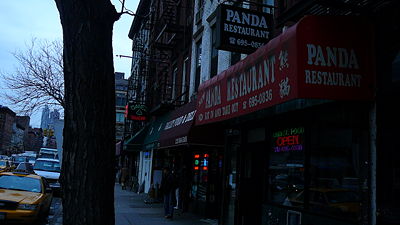
- Pizzerias
- A West African Food Market
- All sorts of different diners
References
- Campbell Robertson, NY Times: The Actor's Temple
- Plan NYC: No. 7 Plan Extension
- Hudson Yards
- NYC Department of Transportation
- Jacob Javits Center Expansion Plans
